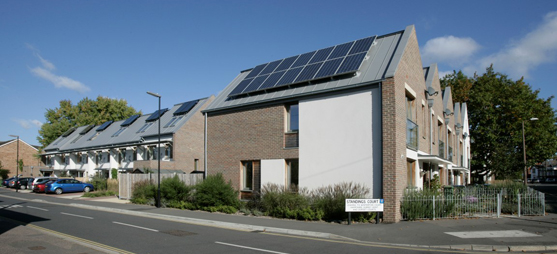Standings Court
| Location: Horsham, West Sussex | |
| Completion Status: Completed April 2012 | Occupancy: Occupied since 2012 |
| Architect: mh Architects | Consultant: Warm Associates |
| Contractor: Geoffrey Osborne Limited | Client: Saxon Weald Housing Association |
| Certification: May 2012 | Certifier: WARM |
| Share this project: | |

Finalist in the Architectural Design Category of the UK Passivhaus Awards 2014. Redeveloped brownfield site providing 38 homes, of which 12 reach Passivhaus standard; this low energy scheme comprises Code 4 and Code 5 flats and houses. The houses are arranged into a series of terraces that form a coherent street block, optimising orientation and forming ‘green rooms’ around mature trees.
This disjointed and underused, yet prominent site was approached as an opportunity to ‘stitch’ the site back into its context with well positioned blocks and attention to key movement routes. The bulk of the site is aligned roughly on a south west axis lending this area to the Passivhaus homes. Using the existing trees, orientation and pedestrian routes we established a loose building grid responding to the existing Victorian homes across New Street and allowed the formation of communal ‘green rooms’ around mature trees.
Using 3D modelling to analyse constraints and design solutions, a simplified form drawing from the nearby Victorian terraces was established as the preference for the Passivhaus'. We were conscious of the need to simplify detailing but also of the importance of the relationship with the street and creating a legible rhythm to the elevations. We bookended the terraces by putting the four beds at the end, raising their roofs and introducing protruding bays. Aesthetically, the bricks draw from the context while render is used to reflect the cutting edge nature of the development. Key innovations included the integration of terraces over rooms and projections and their associated detailing challenges; also as a 100% affordable rented site, all homes achieve the Lifetime Homes Standard, this scheme also offers useful post occupancy feedback and data for the Housing Association sector.

As the design progressed, glazing sizes were reduced and the bay windows were replaced with standard windows. Window positions and sizes were carefully balanced to ensure that good levels of natural surveillance to key outside spaces could be provided, while avoiding excessive glazing areas on north, east and west elevations. Solar hot water panels on the Passivhaus homes provide a good proportion of their domestic hot water, further reducing the homes energy requirements. Gas boilers and radiators provide back up to the solar panels.
Since the project’s completion and occupation in April 2012 a number of units have been monitored as part of a post occupancy energy usage assessment by SRE Ltd. The first year’s data showed that the Passivhaus’ averaged a 67% reduction in their PHPP modelled gas consumption.
Further Information:
.gif) |
.gif) |




